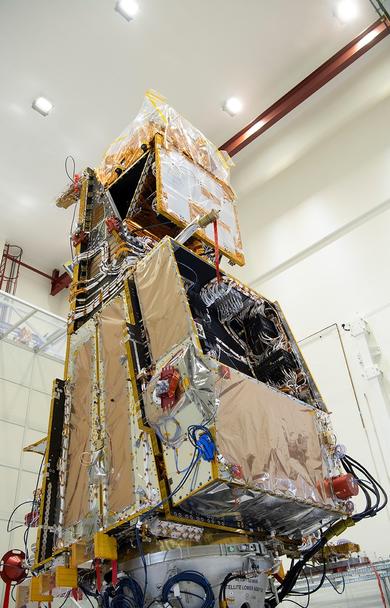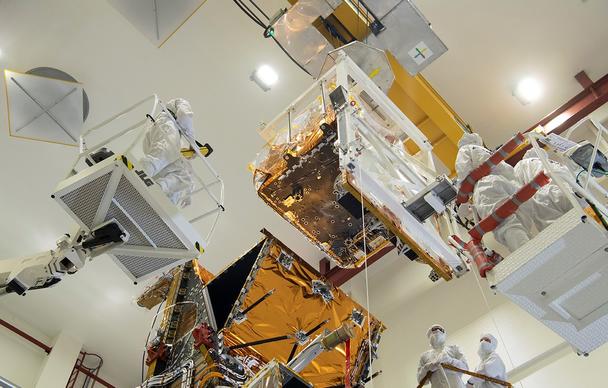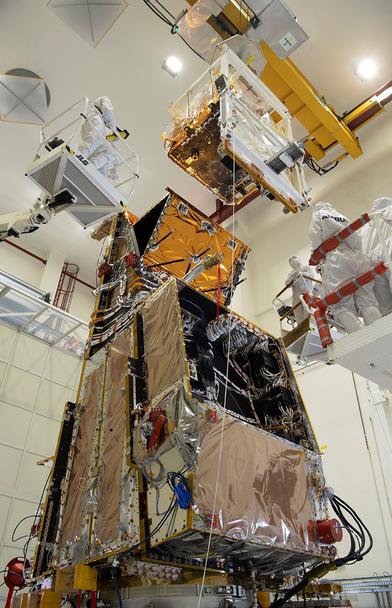Weather monitoring counts on a powerful new tool

Toulouse, 25 October 2022 - Four times more precise than its predecessor, IASI-NG will provide vital data for weather forecasting, pollution monitoring and climate research. A true partnership between Airbus and French Space Agency CNES, the Airbus team has just integrated the first IASI-NG flight optical instrument onto the MetOp-SG weather satellite ‘A’ that will carry it into space.
The most complex of the satellite’s instruments, IASI-NG is the Infrared Atmospheric Sounding Interferometer: it will determine temperature and water vapour profiles in the atmosphere, record ocean surface and land temperatures and monitor a wide range of chemical compounds and other key variables for climate research, including greenhouse gases, desert dust and cloud cover. Two other IASI-NG instruments will later equip the two next MetOp-SG satellites A to cover more than 20 years of weather and environment monitoring.
“At Airbus, we constantly aim at providing the best technological solutions to scientists around the world to better understand the processes that determine the planet’s climate,” said Philippe Pham, Head of Earth Observation and Science at Airbus. “IASI-NG will be a key instrument for weather forecasting and to monitor the climate’s health at any moment in time to secure life and property on Earth.”
Why do we need IASI-NG?
IASI-NG's ability to detect and accurately measure the levels and circulation patterns of gases that are known to influence the climate will be invaluable to scientists. In parallel, this Infrared Atmospheric Sounding Interferometer will measure atmospheric temperature and moisture, and trace gases such as carbon monoxide, nitrogen oxides, methane and ozone, giving a full picture of the atmosphere’s characteristics at any given time.

How does it work?
IASI-NG is a state-of-the-art, sophisticated sounding instrument that will be used for global measurements of atmospheric temperature and moisture with unprecedented accuracy and spectral resolution to improve weather prediction. The optical interferometry process offers fine spectral samplings of the atmosphere in the infrared band between the wavelengths of 3.2 and 15.5 microns. This enables the instrument to establish temperature and water vapour profiles in the troposphere and the lower stratosphere, as well as measure concentrations of ozone, carbon monoxide, methane and other compounds. The instrument should provide nearly an order of magnitude improvement in the vertical resolution of temperature and humidity profiles in the atmosphere, which will result in significant improvements in weather forecasts.
Twenty years of invaluable climate data
MetOp-SG is a continuation of the successful MetOp first generation series of satellites, which currently provide critical meteorological observations from polar orbit. These valuable contributions will be enhanced and provided by the MetOp-SG satellites from mid-2020 up to the 2040s.
MetOp-SG consists of two, parallel series of satellites (A and B), with three in each series. The A series, being built at Airbus in Toulouse, carries atmospheric sounders and optical/infrared imagers, while the B series, under construction at Airbus in Friedrichshafen in southern Germany, focuses on microwaves. MetOp-SG is a cooperative undertaking between the European Space Agency (ESA) and EUMETSAT, the European Organisation for the Exploitation of Meteorological Satellites. The first launch of the MetOp-SG mission is scheduled for 2025 after completion of integration and satellite level testing. The nominal operational lifetime of each MetOp-SG satellite is 7.5 years, ensuring full operational coverage over a 21-year period.

@AirbusSpace @EUMETSAT @ESA_EO #MetOpSG #SpaceMatters
Your contact
Ralph Heinrich
Head of External Communications - Airbus Space Systems
Jeremy Close
External Communications - Airbus Space Systems, UK
Francisco Lechón
External Communications - Airbus Space Systems, Spain
Guilhem Boltz
External Communications - Airbus Space Systems, France